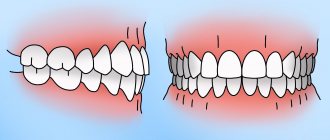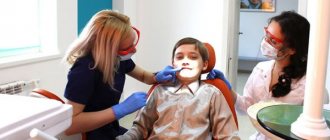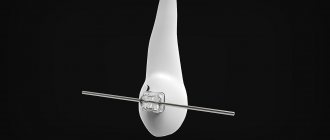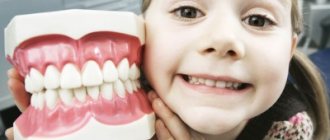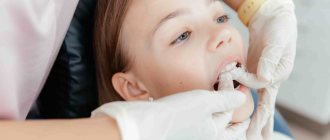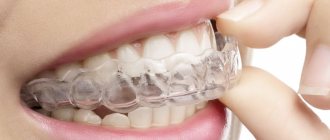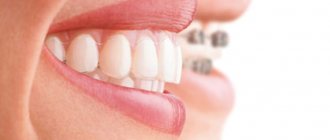This is a frequently asked question on health forums, and we're here to answer it. Beautiful and healthy teeth are not an easy task. Here you need to follow the recommendations of a specialist, a visit to the dentist and the appropriate model and company that manufactures the trainers. The process and speed of obtaining the first results depends on this.
Night guards are useful not only for children, but also for adults, since it is a universal system and has no age restrictions. The model is designed to prevent and combat dental anomalies. For adults, this is a real salvation, since you can fix even what is neglected.
Before purchasing a trainer, you need to consult with an orthopedist; he will tell you about the treatment method and select the right model.
What are dental trainers?
Dental trainers are a double-jaw orthodontic device that tightly secures the upper and lower dentition, gradually correcting the incorrect position of the teeth, training the facial muscles and fixing the tongue in the correct position. The design has several components:
- outer part with lip bumpers;
- labial protrusion in the form of an arc;
- part in the oral cavity (tongue stop);
- “tongue”, which is located on the front part from the inside.
Design Features
Visually, the I3 trainer resembles a classic two-jaw mouthguard used by professional athletes. The structure of the device provides perforation of the surface, ensuring free breathing while wearing. The outer part of the device is made of a silicone layer, the inner side is made of polyamide material.
The use of two-layer technology promotes the expansion of the maxillary arch, which is influenced by the elastic base of the device. At the same time, labial arch elements equipped with a built-in frame reduce the intensity of development of the lower jaw. Muscle memory for the correct position of the tongue is formed due to the built-in marker-limiter, which also helps correct speech defects. High sides wean the child off mouth breathing, which helps develop a proportional facial structure.
What are dental trainers for?
A trainer for straightening teeth is usually prescribed to children aged 5 - 12 years, during the period of mixed dentition. Timely use of the device will eliminate serious problems in the future, since in adulthood, when the jaw bones are already formed, the bite can only be radically corrected through surgery. However, doctors warn that correcting teeth with trainers will only be useful if you follow the wearing regime. If a small patient is not motivated enough or his parents cannot control the process, the technique will not bring results.
A dental trainer for children is prescribed for the following indications:
- mouth breathing;
- parafunction of the tongue;
- bad sucking habits;
- improper eruption of front teeth;
- narrowing of the dentition;
- various malocclusions;
- pronounced crowding of teeth (the teeth do not have enough space on the gums, and they move each other).
Dental trainers are also used to treat patients over 12 years of age who already have a permanent bite. They are used for the following diagnoses:
- class II anomalies (subclasses 1 and 2, distal displacement of the lower first molar in relation to the upper one);
- crowding of the front teeth;
- deep or open bite.
An important purpose of trainers is to form the correct functioning of the jaw muscles, which is very difficult to achieve with the help of plates or braces. A separate function of silicone teeth trainers is retention after wearing braces. However, in most cases, trainers are prescribed to children.
Price
These devices are not an expensive pleasure and almost anyone can buy them. The average cost ranges from 2000 to 6000 rubles .
This significantly distinguishes the designs from brace systems, which are many times more expensive, especially those made of expensive materials or invisible to others.
The price depends on the number and cost of orthodontic consultations and the cost of the trainers themselves.
With the help of these devices, it is easy to correct malocclusions; it is important not to delay the start.
Trainers for teeth - children and adults
In pediatric and adult orthodontics, various models of trainers are used to straighten teeth, each of which has its own purpose.
Trainers for teeth T4K
For older children, T4K dental trainers, the so-called pre-orthodontic ones, are suitable. Treatment on such trainers takes place in two stages - first, the patient wears a soft initial device (blue), then, upon achieving the goals, it is replaced with a more elastic one (pink or red). T4K dental trainers are suitable for early and late mixed dentition. There are also models of trainers for teeth i-3 and i-2 and their varieties, specially designed for the treatment of class 2 and 3 anomalies.
Teeth Trainer T4A
T4A dental trainers are available as initial and final trainers. Initial (blue) is used on replacement teeth. It has a special recess so that the child understands where to put his tongue. This species is almost imperceptible in the mouth. The period of its use varies from 6 to 8 months. The final pink T4A dental trainer provides a more rigid hold on the dentition. You need to wear it for another 6 to 12 months.
Teeth trainer i-3
The i-3 teeth trainer is used to prevent bite defects during the early change of baby teeth. Its wearing period ranges from 4 to 8 months.
Teeth trainers T4A for adults
Orthodontic trainers for teeth T4A are in many ways similar to T4K for children, they are distinguished by slightly increased height of the sides of the labial arches and longer distal ends. Such devices are also available in two types of hardness - initial and final. Such trainers help in the cosmetic alignment of the front teeth and in minor relapses after orthodontic treatment.
Advantages and disadvantages of the method
Like any orthodontic method, installing trainers is not suitable for everyone; this device has its pros and cons .
- Children's devices are made in color to add emotions to the process of wearing them, while adults can undergo treatment without unnecessary attention to their smile, since the trainers of this line are most often colorless.
- The method does not cause much trouble to use, since the structures are often worn at night, and during the day they can be worn for only an hour and this will be enough for the process of straightening the teeth and easing muscle pressure.
- When using trainers, a person may not feel anything, since they do not create a feeling of discomfort.
- These devices are accessible to many; their price is an order of magnitude lower than the cost of braces or plates.
You can find out the prices for trainers for straightening teeth in adults in the following article.
In a separate publication we will talk about how to correct crooked teeth without braces.
Follow the link https://orto-info.ru/sistemyi-vyiravnivaniya-zubov/lechebno-profilakticheskie-apparatyi/treyner-t4a.html you will find reviews of the T4A trainer for adults.
How long and how to wear a dental trainer?
The duration of treatment with trainers will depend on the diagnosis. The minimum is 11 - 12 months. In some cases, after wearing trainers, further orthodontic treatment with braces or Invisalign aligners may be required. However, the period of additional treatment will be shorter than without first wearing dental trainers. How to wear a dental trainer? During treatment, the patient wears the device for at least an hour a day and wears it at night.
How to put on a dental trainer? To install the device, you need to place it with the “marker tongue” up and place it so that the tongue touches this “tongue”, then lightly press it with your teeth. Keep in mind that with the trainer installed in your mouth, you can only breathe through your nose. Before putting on an orthodontic trainer, you must thoroughly brush your teeth and wash the device itself with a cleaning agent.
What are they?
This is an elastic splint made of soft material, thanks to which the design fits almost any jaw. Trainers are used to correct malocclusion and abnormal tooth growth.
It has been proven that malocclusion is formed due to the active influence of the maxillofacial muscles on the dentition.
Trainers help reduce the intensity of this pressure and also help get rid of bad habits in children and adolescents, such as thumb sucking, pencil sucking and other objects.
Photo: orthodontic trainer on teeth
Appearance
There are several types of trainers for different purposes. Some are used for baby teeth, others during treatment with braces, and others simply to prevent the development of dental growth abnormalities.
They differ from each other in color. Multi-colored ones are often produced for children, and transparent ones for adults.
What problems do they solve?
These designs are necessary for the prevention and treatment of anomalies in the location of teeth in a row.
These devices are popular due to their action. They are made to eliminate not the symptoms of anomalies in the location of the jaw or teeth, but the reasons why the anomaly developed.
These orthodontic structures allow you to achieve a positive result and consolidate it at the same time . That is, their use minimizes the risk of relapse.
Doctors also prescribe these structures to help a person develop nasal breathing and to accustom the tongue to the correct position.
Trainer care rules
- The orthodontic trainer should be washed with running water after each meal, but it is contraindicated to use boiling water or ice water.
- The device must be cleaned at least twice a day with a brush and paste.
- The orthodontic dental trainer should be stored in a special container.
- The teeth straightening trainer should not be dropped, chewed or moved in the mouth while talking.
If cracks or damage appear on the device, it is necessary to immediately inform the attending orthodontist, since the structure may lose its properties, and bacteria may accumulate in the cracks.
The lineup
The device, developed for the purpose of correcting occlusion at the transitional stage, is aimed at patients in the age category no older than nine years. The I3 model range includes three types of products, differing in size and functional impact:
- Small is the smallest model in the line, recommended for children under 5 years old, with a maximum height of the side elements of up to 2.1 cm (optional reduction by 30 mm) and a recess for the upper labial frenulum of 1.8 cm.
- Medium is an average option, suitable for a child aged 5 to 8 years, with the height of the sides being 2.4 cm and the recesses being 2.1 cm.
- Large - the maximum size of models used by children 8-9 years old, with sides of 2.45 and a recess of 2.5 cm.
To adjust the height of the sides, use ordinary sharp scissors, with which the silicone edge is carefully cut along the outer edge.
Operating rules
The advantage of the I3 trainer is that there is no need to constantly wear the structure. To correct bite defects, it is enough to install the device for two to three hours during the daytime, and also for 7-8 hours during sleep. The presence of perforation prevents difficulty breathing. The procedure for putting on the device includes a number of simple recommendations:
- The marker tab should be located on top of the trainer;
- The device is placed in the oral cavity;
- The tongue should touch the marker;
- The trainer is compressed by the jaws without much effort;
- The child closes his mouth and closes his lips, breathing only through his nose.
During wearing, a number of rules must be observed, control of which rests with the child’s parents. So, with the design installed, the lips should be tightly closed, the tongue should be in the correct position, and breathing should be carried out only through the nose. At the initial stages of adaptation, problems may arise, but over time a habit is formed, and the child stops paying attention to the installed trainer.
The duration of treatment depends on the specifics of the identified pathology, and varies from six months to 10 months, and in particularly complex cases – up to one and a half to two years. The operating instructions provide for regular washing of the trainer after each session - to do this, just place the structure under a stream of warm running water, and then put it in the case that is included in the kit.
The first results appear only after 2-3 months of regular use of the trainer. There is an improvement in nasal breathing, restoration of the natural position of the lips, and, subsequently, straightening the position of the jaws relative to each other.
General overview
The device, developed and patented by the Australian company MRC, is recommended for the correction of third-degree malocclusions. The anomaly is characterized by a medial displacement of the lower chewing units relative to the antagonists - the upper jaw clearly overlaps the lower jaw, which creates discomfort, causes problems with diction, and generally worsens the aesthetics of the smile. The I3 trainer creates and maintains a coordinated load on the muscles and ligaments of the jaw apparatus, helping to restore natural occlusion.
Prices
The cost of dental trainers is quite affordable - from 2,500 to 6,000 rubles. Consultations with orthodontists are paid separately, the cost differs depending on the pricing policy of the clinic (on average from 500 rubles).
It is important to note that you should not expect a miracle from treatment with trainers. These structures are not able to cope with complex occlusion pathologies, which can only be cured with devices that exert strong mechanical pressure (braces and plates).
It makes sense to wear trainers only if prescribed by an experienced doctor, who will determine all the features of dental anomalies and consider that trainers will cope with these anomalies. You can find such a qualified orthodontist in the database of dental clinics on our website.
Expected Result
The first results will not appear quickly. The effect is achieved after prolonged use. The first noticeable improvements will be noticeable only after 2 – 3 months.
During the treatment process, nasal breathing will gradually begin to improve, then the position of the lips will be restored, after all this the position of the jaw arches in relation to each other will gradually change.
How does a fixed Haas appliance work when correcting malocclusions in children?
In this publication you will find all the most important things about the Klammt activator.
Follow the link https://orto-info.ru/sistemyi-vyiravnivaniya-zubov/lechebno-profilakticheskie-apparatyi/chto-takoe-vint-bertoni.html to get closer to the features of the Bertoni screw with three guides.
Who and at what age is recommended to use the trainer?
The earlier a problem is detected, the better and the easier it is to cure. blue orthodontic is designed to work with mixed bites, so most often they begin to wear it at 6 years of age and complete therapy at about 10 years of age. But there are exceptions: sometimes an orthodontist can recommend a device as early as 4 years old. It all depends on the specific case and the characteristics of the child’s dental system.
Indications
Indications for using a soft blue T4K trainer followed by a transition to a harder version are the following child problems:
- crowding of teeth in the frontal region of the lower jaw;
- formation of an open bite under the influence of bad habits;
- the appearance of a deep bite;
- incorrect position of the lower jaw, which does not require surgical intervention;
- distal occlusion (also called “posterior bite”) with protrusion or retrusion of anterior teeth;
- weak anterior bite.
The device is prescribed for the development of bad habits, such as thumb sucking or inserting the tongue between the teeth. A trainer can ensure proper swallowing and solve some speech problems.
Contraindications
In some cases, trainers cannot be worn: they either will not be effective or may cause harm. From the orthodontist’s point of view, there are three such cases:
- deep anterior bite (mesial occlusion), in which the lower jaw is strongly shifted forward and the trainer simply does not fit;
- lateral crossbite that cannot be corrected with splints, trays or aligners. It is treated only with braces;
- serious difficulties with nasal breathing. If there is pathological obstruction of the nasal passages, the child will not be able to breathe while wearing the device.
You should not purchase a trainer if you have an allergic reaction to silicone. This happens extremely rarely, because the material is hypoallergenic, but there is a small percentage of people who cannot tolerate it.

